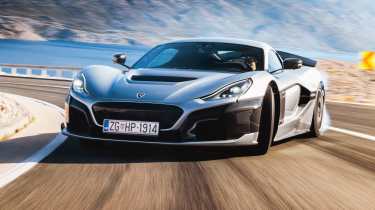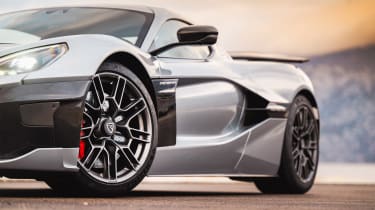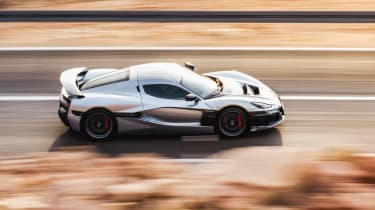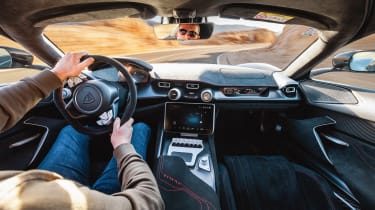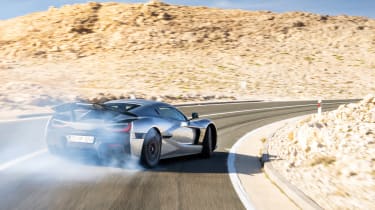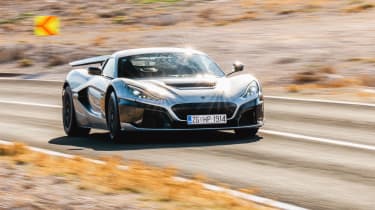Rimac Nevera review – an astonishingly capable electric hypercar
Despite its bonkers 1888bhp output, the Nevera is far from a one-trick-pony, proving to be one of the most involving hypercars we’ve driven to date
Even after just 30sec in the 1.7 million pound, 1888bhp, 258mph Rimac Nevera, you can tell it’s special. You can tell it’s different compared with any other uber-fast car you’ve ever driven, be that conventionally or electrically powered.
For starters it rides PERFECTLY for a car like this. From the way it filters away all the unwanted stuff that goes on beneath your hands and backside, creating sound but not noise as it glides serenely across the landscape. The Nevera feels instantly like the product of a manufacturer that’s been honing its craft for decades, not just a few years.
Yet here it is, a brand-new hypercar from what is still a largely unheard-of car manufacturer that emanates not from Germany or Italy (or England) but Croatia. And if the revelations it unleashes in the first few hundred yards are enough to fry the space between your ears, they are nothing compared with what’s to come – because, trust me, when you DO finally let rip in it, the Nevera does stuff that no other road car on this earth can get anywhere near. Not even close. And not just in a straight line but around corners and under brakes as well. More on which in a bit.
More reviews
In the meantime, what actually IS the Nevera and how come it’s as good as it is, straight out of Compton?
As you’ll probably know, it is powered entirely by electricity, and at its core sits a carbonfibre tub that’s neither front, mid nor rear-engined in the traditional sense, because the 120kWh battery pack it contains is mounted across the floor to provide it with near-perfect 50:50 weight distribution. So although the Nevera weighs rather a lot at 2150kg, the mass it carries is in the best place possible, namely, nice and low down in the chassis and not remotely stacked up at one end.
> The 2078bhp Rimac Nevera R is a more powerful version of the world’s quickest car
I’m not sure you’d be all that interested to know about the cylindrical cell formation of its 730v battery pack, or that it contains 6960 individual cells that are cooled by liquid and made from lithium manganese nickel because, well, it doesn’t sound as sexy as saying it’s propelled by a 6.5-litre V12 whose cylinders are lined with unobtanium and which revs to an ear-splitting 9000rpm. What might be of interest, however, are the headline numbers its EV powertrain produces, plus the technology it employs to transmit its prodigious energy to the road.
It has four electric motors and four gearboxes, each of which drives one of its four driven wheels. The e-motors at the front each produce 295bhp and 206lb ft to give a total of 590bhp and 412lb ft – across the front wheels. At the rear, the motors are somewhat beefier and produce 644bhp and 664lb ft. Each. This gives a combined total of 1288bhp and 1326lb ft – purely at the back wheels – which ultimately provides an entirely surreal-sounding 1888bhp and 1739lb ft combined total.
The gearbox at the back is described as ‘a double single-speed’ in which a pair of one-speed gearboxes are mounted within the same housing that sits smack in the middle of the two electric motors, which sounds, and indeed is, unfathomably clever.
Much like the suspension, which, on the surface, would appear to be refreshingly conventional in its design in that it features double unequal length wishbones at each corner with electronically adjustable dampers all round. Yet in reality it is anything but.
As you can imagine, traction is always going to be an issue with the thick end of 1900bhp on tap, and the Nevera’s uber-complex ESC system has been tuned by Rimac to work extraordinarily well in practice. To a point where up to about 100mph you never actually get full beans in the Nevera, not even in Track mode, not unless you switch everything off, which is not something you should do in a hurry, trust me.
Instead, the ESC constantly hunts for the best grip at each wheel, allowing either a small amount of slip or a fair bit, depending on which of the five drive modes you’ve selected. These consist of Range, Cruise, Sport, Track and Drift, each mode providing a different set of maps for the dampers, throttle, ESC, steering and aero.
The aero package, as you might imagine, is also pretty trick and contains ‘active elements’ at the front and rear, and along the car’s underbelly as well. A variety of hydraulically operated wings and ducts are automatically deployed as the car accelerates, brakes and corners, the whole lot being controlled by the same potent ICU that takes care of the ESC, dampers, throttle, steering, brakes, you name it.
Talking of brakes, the Nevera inevitably features vast carbon ceramic discs with 6-piston callipers at all four corners. Again, these are primarily operated by electronics (although if the e-systems fail they still work conventionally, as does the steering, which is nice to know) and form an integral part of the car’s ability to regenerate power on the move, so getting them to feel natural was never going to be the matter of a moment. In the event, it took Miroslav and his engineers ‘a seriously f***ing long time to get them right’ but as with so many other aspects of the Nevera, the end result is key to the car’s refreshingly analogue-like feel on the move.
However long it took, it was worth it. From the way it stops to the way it steers to the way it goes around corners and, yes, to the absolutely ridiculous way in which it accelerates between those corners – the Rimac Nevera drives like no other road car there has ever been. Ever.
From a pure speed point of view it changes everything. Its acceleration is so total and so immaculate in its clarity that when you put your foot down hard for the first time, your brain struggles for a moment to process what’s going on. It feels like you’ve left a sizable chunk of your conscious mind way behind to begin with. It's so quick, indeed, it makes a 1600bhp Bugatti Chiron Supersport seem positively weedy by comparison. I know this because we had a Chiron SS along with us when I drove the Nevera, more about which you can read next year.
I kept my foot in until about 180mph at one point on a section of road that Rimac had managed to close for our test, and it was still pulling as hard as it does at 50mph. Genuinely. Some years ago I drove a then-contemporary Formula One car around Silverstone, and that was quite punchy in a straight line. But I’m telling you here and now, the Nevera feels quicker than that up to 80-90mph, and every bit as rapid from there on up. The raw numbers would suggest as much, too. Zero to 60mph takes under 1.8sec according to Rimac while 0-100mph takes four seconds flat. The standing quarter comes and goes in just 8.6sec – which is pretty crackers for a road car – and to hit 186mph (300kmh) it needs less than 10 seconds.
Thing is, intoxicating as the Nevera’s crazed straight line performance unquestionably is – to a point where I can’t imagine you’d ever get used to it, ever – what’s more impressive still, for me at least, is the level of feel it has on the move. The way you can lean on it through a quick corner and sense through the seats and via your hands precisely how much torque is being metered out through each wheel is just lovely. And when you select Track or Drift modes you can even slide it about a bit if you fancy your chances, or just tighten the nose towards the exit of a corner by opening the throttle sooner and harder. And yet it doesn’t seem to bite. The computers have clearly been asked to deliver maximum edge and as much feel through the steering and seats at all times, it seems. As a result, the Nevera feels a bit like the world’s fastest and most sorted M3 but with four times more of everything and much, much nicer steering.
Making a car that’s insanely fast is one thing, but making one that also bubbles with feel and has such delicacy to its controls at the same time is just pure genius. And if after a day of driving it you then watch it get charged up from almost zero to 100 per cent in less than 20 minutes, right in front of your eyes, it’s not long before the penny begins to drop. OK, the charging infrastructure is nowhere where it needs to be in the UK yet but being able to feed 300 miles into the Nevera in around 18 minutes is almost as much of a game changer as the car itself. Especially when it costs no more than 30 quid to do so.
But in the end it’s not the Nevera’s apocalyptic acceleration or its towering brakes, or even its surreal ability to charge up so rapidly that blows your mind the most. It is instead how damn entertaining it feels in the process, and that surely means it serves up the best of both worlds: the unrivalled straight-line insanity of a mega-high output EV with the driver appeal of what often feels quite a lot like an old school supercar.
Result? The Nevera is way more than just another mind-warpingly fast EV. It’s so good to drive in so many unexpected ways it feels like it could easily have been created by Porsche’s GT department. And I sincerely hope Rimac takes that the right way because, in our world, compliments don’t come much higher than that.
Rimac Nevera specs
| Motors | 2 x 220kW front; 2 x 480kW rear |
| Power | 1888bhp |
| Torque | 1742lb ft |
| Weight | 2150kg |
| 0-62mph | 1.81sec |
| Top speed | 219mph (258mph unrestricted) |
| Battery | 120kWh |
| Price | £1.72m |
